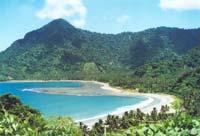Mining permit threatens Galapagos of Asia

Born in geological isolation, the ice-age island of Sibuyan in the Philippines archipelago is one of the last natural frontiers in the world.
Called the Galapagos of Asia, the crescent-shaped island in Romblon Province is home to the world’s densest jungles, a protected mangrove forest and hundreds of plants, birds, mammals and reptiles some of which have yet to be catalogued.
Beneath this natural wonder also lies a treasure trove of minerals.
Now cash-strapped Manila has granted a permit to a Canadian firm to mine on Sibuyan Island, a move which has triggered anguish and anger by naturalists and residents who say the operations will be detrimental to one of the richest environments on the planet.
According to the group Sibuyan Island Sentinels League for Environment Inc. (Sibuyan ISLE), Altai Philippines Mining Corporation (APMC) was granted a permit the Department of Environment and Natural Resources (DENR) recently to explore for minerals 1,822 hectares of land on Sibuyan Island and the tidewaters of the Visayan sea.
Altai Philippines Mining Corporation is a subsidiary of Altai Resources Inc. a Canadian resource company with a diversified portfolio of natural gas, gold, nickel and industrial mineral properties in Canada and the Philippines.
“This is a clear disrespect to Sibuyanons. The government, through the DENR, has proven itself again as an agent of destruction,” said Sibuyan ISLE executive director Rodne Galicha, according to media reports in Manila.
Galicha cited typhoons Frank, Nina and Feria that devastated the island, as well as continuous illegal logging, mining, and fishing which the DENR allegedly failed to address.
“Now, large-scale mining? All of us in our island, whether pro-mining or anti-mining, are all victims here. We are being stabbed behind our backs,” he said.
Anti-mining group Alyansa Tigil Mina also criticized the move saying, “The small island of Sibuyan is a declared mangrove forest reserve under Proclamation 2152 by then President Marcos which falls under the National Protected Areas System and that the approval of the large scale mining permit runs counter to the intention of the proclamation.”
Haribon executive director Blas Tabaranza Jr. cited concerns on the effect of the mining explorations on Sibuyan Island’s biodiversity, according to the Inquirer.
“The island is very sensitive when it comes to ecological diversity. Even the feasibility study suggests that there are tree species banned to be cut in the area, not counting the endangered flora and fauna,” Tabaranza said.
“Sibuyan Island is an important bird and biodiversity area (IBA), the flora and fauna are so unique and diverse the fact that the island has been separated from any other islands since ice-age,” he said.
Domingo Marin, President of of Sibuyan-based advocacy group Sibuyanons Against Mining (SAM) supported by Sibuyan ISLE, says that “Sibuyan folks are disgusted and annoyed with this kind of development, we were not even informed about the approval and have no news whatsoever.
“Is this the kind of justice they want to give to my son, to my fellow Sibuyanons, to our children’s children?” says Marin, whose son, an anti-mining activist was murdered.
The granting of the permit is part of the continued efforts by Philippine President Gloria Macapagal Arroyo who has been aggressively wooing foreign investments in the mining sector since the country’s Supreme Court ruled that a law allowing foreign control of local mining operations is constitutional, about two years ago.
The cash-strapped government has said that the top 23 mining and 37 exploration projects around the country, which involve several Canadian companies, could generate $6 billion in new investments over the next five years and create 1 million jobs.
It said the country’s mineral reserves are estimated to be worth about $800 billion, and the industry could raise about $2.2 billion annually, enough to wipe out the country’s fiscal deficit.
Sibuyan Island at a glance
Sibuyan is a crescent-shaped island of Romblon Province, Philippines.
It has an area of 445 sq km.
Mt Guiting-guiting Natural Park was established to protect these forests, which are mainly in the centre and north of the island, and covers an area of about 157 sq km out of Sibuyan’s total area of 445 sq km. The Park is remarkable for its outstanding scenic landscape with twin towering peaks set amidst closed canopy forests.
The island has lived with its isolation from the rest of the world since its birth.
Never in its geological history has it ever been connected with any part of the Philippine archipelago. Seismic forces pushed up a 2,000-meter peak from the earth’s crust, forming a series of smaller peaks and slopes.
The peak is Mt. Guiting-guiting (literally means “the saw-toothed mountain”, in reference to its jagged ridge.
And because of the steep slopes, much of its original forest remains untouched, and the rest is the island as we find it today.
Exact figures of plant species are hard to give, as biologists continue to stumble upon species yet unidentified by the scientific community.
In one study, the National Museum identified 1,551 trees in a single hectare, with 123 species of trees. Of this number, 54 are found nowhere else in the world. Sibuyan’s forest has been proclaimed as the world’s densest forest.
There are estimated to be 700 vascular plant species on the island.
There are 131 species of birds that share the skies with ten species of fruit bats, and the plethora of land-dwelling mammals, reptiles, and rodents have yet to be fully catalogued. It is likely that several of these birds will prove to have important populations in the extensive forests of Mt Guiting-guiting.






